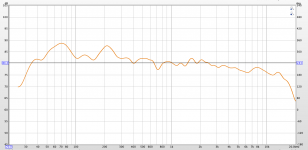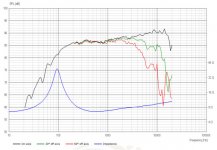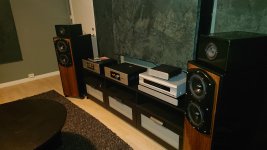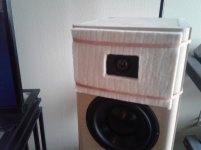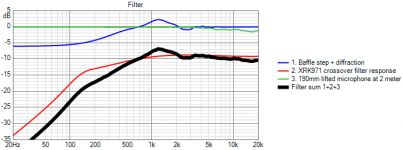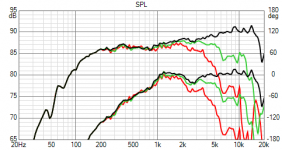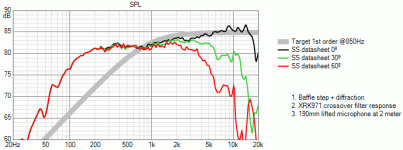xrk971,
What is the nominal centre distance between 10F and RS225 if I maintain the xover at about 900Hz? Thanks.
What is the nominal centre distance between 10F and RS225 if I maintain the xover at about 900Hz? Thanks.
So, I've been experimenting with a MLTL version similar to the one in this thread, adapted to my driver, and I have been testing with a lot of drivers, mainly the B80, SB65, SB10, TC9 and even some ceramic and ribbon tweets.
Funnily enough, the one that meshed the best with the least amount of tinkering is the TC9. Plus, it sounded great, too.
So, if one wants to try X's design, but doesn't want to shell the big bucks for a 10F driver, the TC9 is a very clean and snappy driver alternative that would not disappoint. It performs way beyond its price point.
I really like my other drivers, and some perform better in certain circumstances, but in this design, it was just so easy to integrate the TC9 with the MLTL that it made it a no brainer.
The peaks at 70 and 210 are room nodes... didn't bother to move the enclosures so much, more interested in the meshing between the woofer and the TC9. Still need to tweak the XO, but came up with this within 15 min of tinkering, so can only get better with a little more time spent on it.
Funnily enough, the one that meshed the best with the least amount of tinkering is the TC9. Plus, it sounded great, too.
So, if one wants to try X's design, but doesn't want to shell the big bucks for a 10F driver, the TC9 is a very clean and snappy driver alternative that would not disappoint. It performs way beyond its price point.
I really like my other drivers, and some perform better in certain circumstances, but in this design, it was just so easy to integrate the TC9 with the MLTL that it made it a no brainer.
The peaks at 70 and 210 are room nodes... didn't bother to move the enclosures so much, more interested in the meshing between the woofer and the TC9. Still need to tweak the XO, but came up with this within 15 min of tinkering, so can only get better with a little more time spent on it.
Attachments
perceval,
Thanks for sharing. I was also thinking about popping in the TC9 and having a listen.
I'll probably have to make a new baffle though.
Thanks for sharing. I was also thinking about popping in the TC9 and having a listen.
I'll probably have to make a new baffle though.
Yes, the TC9 achieves 90% of the 10F at 10% the price. It’s not surprising that it’s part of some of the best sounding speakers I have ever heard. Wesayso’s Two Towers uses 50 of them. 🙂
I will have a go with the TC9/RS100 version for my bedroom ( tv ) speakers 😀
Thanks for sharing guys
Thanks for sharing guys
Last edited:
Regarding build material, has anyone tried using 0.75" MDF as a backing material? Either for the main back on the sealed build, or the internal backer and the main backer for the TL version? Wondered if that had been thought of or whether it doesn't have an effect (I've seen it reference a couple of times on audio forums but wasn't sure, main reasoning is that the MDF deadens the reflections a little).
Additionally, would widening the buffer by 0.5/1" have a noticeable detriment to audio quality? What about a 3mm acrylic plastic laminate over 15mm B/BB for the front? (Realize both would detract from performance, but this is judging performance vs aesthetics to be allowed to put them in the main room lol)
Additionally, would widening the buffer by 0.5/1" have a noticeable detriment to audio quality? What about a 3mm acrylic plastic laminate over 15mm B/BB for the front? (Realize both would detract from performance, but this is judging performance vs aesthetics to be allowed to put them in the main room lol)
I don't think there is a significant difference between type of panel used, even though some people will say otherwise. That said, sandwiching two different panel material will help dampen vibrations. To save cost, you could fix thicker MDF to a thin external noble wood panel. Personally, i would apply a layer of some sort of roofing material on the inside of whatever panel i choose. Also, an idea would be to put roofing material between two panels. Many things to try....
Hope it helps.
Hope it helps.
Last edited:
I think there have been MDF builds in this thread. An inch wider baffle might be ok, but I can’t guarantee the passive crossover will be as good anymore. Probably fine though. BB sandwich with latex caulking of green glue is good. The mass loaded butyl autosound sheets are are also very helpful. But the XPS faced with thin plywood is excellent. Super lightweight so easy to transport and performance is great with respect to panel vibrations.
I’ve been following this thread over the years, and I would like to thank everyone for making it so interesting and informative.
There is one thing, however, that I’m not able to get my head around. I’m hoping that someone can help out. Here is the issue:
If you look at the frequency response graph that the manufacturer publishes for the 10F, you will notice a steadily rising output from about 900 Hz. And yet the frequency response measurements in this thread show no such rise — the response stays more or less flat. I may have missed something, but I seem to recall that no equalisation has been applied in the implementations described here. If that is indeed the case, what is the mechanism by which the response of the driver is flattened? Just trying to understand the physics behind it all.
There is one thing, however, that I’m not able to get my head around. I’m hoping that someone can help out. Here is the issue:
If you look at the frequency response graph that the manufacturer publishes for the 10F, you will notice a steadily rising output from about 900 Hz. And yet the frequency response measurements in this thread show no such rise — the response stays more or less flat. I may have missed something, but I seem to recall that no equalisation has been applied in the implementations described here. If that is indeed the case, what is the mechanism by which the response of the driver is flattened? Just trying to understand the physics behind it all.
Attachments
There is a cap and resistor around the 10f (2.2uf and 10 ohm).
That sends some of the hf to ground.
See the schematic on post #1
That sends some of the hf to ground.
See the schematic on post #1
Last edited:
Ah, ok, thanks for this.
So the crossover circuit is also behaving as a fixed "tone control," as it were. Interesting.
(Forgive me, I have long since forgotten what I once knew about electric networks.)
So the crossover circuit is also behaving as a fixed "tone control," as it were. Interesting.
(Forgive me, I have long since forgotten what I once knew about electric networks.)
Also, the speaker is designed around the woofer axis as the principal direction. Mic measurements of the 10F at woofer axis is slightly off axis and this reduces the effect of the rise too. That is listening height dependent but I suggest placing woofer axis at or slightly below ear level.
Or, I suppose, one could place the 10F at ear height but don't toe-in the speakers to face the listening position.
No, you want the woofer at ear height to get the proper time delay for the transient perfect aspect of this speaker. Else I would have placed the 10F on top and not below the woofer.
Nice.
Add 1" felt around 10f and cover top of rs225 box, may sound even better.
Worked well with my dome tweet, not sure with a 3.5" driver, try a bunched up towel first ?
Nsmt does this (i think) in the model 100 speakers.
Model 100
Add 1" felt around 10f and cover top of rs225 box, may sound even better.
Worked well with my dome tweet, not sure with a 3.5" driver, try a bunched up towel first ?
Nsmt does this (i think) in the model 100 speakers.
Model 100
Attachments
Last edited:
Here is some modeled visuals using datasheet curve and probably why it goes relative more flat, the three effects modeled are graphed and listed below plus their summing filter effect..Understood. Thanks!
Static plot of datasheet curves with overlaid sum of filtered model..
Animation of the three filter effcts normalized in SPL to target curve..
Attachments
- Home
- Loudspeakers
- Full Range
- 10F/8424 & RS225-8 FAST / WAW Ref Monitor
